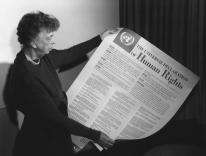Late in May the Surgeon General of the United States issued a new advisory about the effects of social-media usage on young people’s mental health, calling attention to what it declared an “urgent public health issue” requiring “the nation’s immediate awareness and action.” Five days later, the Vatican Dicastery for Communication published Towards Full Presence: A Pastoral Reflection on Engagement with Social Media. The eighty-two-paragraph-long document makes almost no mention of warnings like that in the Surgeon General’s report and other research. And its tone couldn’t be more different—generally approving, right from its opening paragraphs, as evidenced by these lines: “[E]xamples of faithful and creative engagement on social media abound around the world, from both local communities as well as individuals who give witness to their faith on these platforms.”
This expression of the Catholic Church’s relationship with an aspect of modern life seems a far cry from, for example, its stance on psychoanalysis in July 1961, during the pontificate of John XXIII. That’s when the “supreme” Congregation of the Holy Office issued a “Monitum” (a warning) prohibiting priests and religious from practicing psychoanalysis and ordered priests and religious who wanted psychoanalytic treatment to obtain permission from their superior. The prohibition had to do with the conflict between psychoanalytic theory and the Church’s teaching on sexuality. It was issued around the same time that psychoanalysis was first included in college curricula in the United States, between the publication of the first and the second Diagnostic and Statistical Manual of Mental Disorders (DSM-I, in 1952, and DSM-II, in 1968). If the Church’s reflexive response to modernity was once to sound a warning, its reaction to social media seems like an embrace, albeit a chaste one. One wonders if this response reflects a more open and less suspicious vision of the modern world—or simply the impossibility of opting out. The document reflects Pope Francis’s very confident and sometimes too casual attitude towards the media in general. But in Rome they know that traditionalist and/or divisive voices have largely taken over social media and the Catholic digital space. It seems that the institutional Church knows it can no longer do anything about that, and that it may be better to feed the beast in hopes of taming it rather than just remain its victim.
Towards Full Presence is interesting in another way: it’s the first document of a Roman Curia dicastery to be signed by a layperson, Paolo Ruffini, an Italian journalist appointed to the Prefect of the Dicastery by Francis in July 2018 (the secretary of the Dicastery, Msgr. Lucio Adrian Ruiz, also signed it). At the same time, it’s a very papalist document: almost all quotations from Church teaching come from Francis. There is no mention of Vatican II—not the decree on mass media, Inter Mirifica, nor (and this is more serious) from the constitutions of Vatican II, including Dei Verbum, which has something important to say on the Church’s understanding of communication and tradition.
The document was in the making for a few years, growing out of “a reflection involving experts, teachers, young professionals and leaders, lay persons, clergy, and religious.” This pastoral reflection does not offer “precise ‘guidelines’ for pastoral ministry in this area”—maybe a good thing, given that its terminology already seems dated in light of recent and rapid advances in AI (which is mentioned perfunctorily). The document seems to have been written mostly with the loud and divisive U.S. Catholic social-media sphere in mind, but conversely, it also seems to reflect the techno-optimistic, market-of-religion stance to social media held by many influential American Catholics.
The document sees the parable of the Good Samaritan as key in understanding our mutual relations in the digital space, and especially in discerning the moral claims of devout people: “The hope is to promote a common reflection about our digital experiences, encouraging both individuals and communities to take a creative and constructive approach that can foster a culture of neighborliness.” It invites us to imagine a different social media, and it even makes a gesture toward engaging with synodality and the synodal process. The document also invites Christians active in the digital space to go “from encounter to community” and to assume “a distinctive style”:
All that we do, in word and deed, should bear the mark of witness. We are not present in social media to “sell a product.” We are not advertising, but communicating life, the life that was given to us in Christ. Therefore, every Christian must be careful not to proselytize, but give witness.
All of this gives rise to some questions. The Vatican dicastery believes that Catholics’ engagement with social media can be communal: “Our creativity can thus only be an outcome of communion: it is not so much the achievement of a great individual genius, but rather the fruit of a great friendship.” But the fact is that social media has become a tool for promoting, marketing, and selling ourselves as individuals. This is even (perhaps unintentionally) acknowledged in the language of the document—the invitation to “tell stories” and the identification of every Christian as “a micro-influencer.” Ecclesiologically, the notion of communion and community has particular relevance on social media, which feeds an individualism based on a moralistic sense of personal coherence that elevates one’s own self to role model, and so has inevitably divisive effects.
It’s important to note that the document also lays out a warning to bishops, pastors, and prominent laypeople to behave responsibly. But it is a very gentle warning, more exhortative in tone. Nowhere is the issue of regulating the access of Catholic leaders (of all kinds) to social media addressed, and ideas like the “mandatum” for Catholic teachers put forth by Bishop Robert Barron a few years ago are not taken up. It all confirms that no one is in charge of issuing real guidance on the use of social media, one of the “sacraments” of this age of “believers without borders” where the geographical or personal jurisdiction of the bishops over their flock has been completely overridden. Yet the wide range of behaviors by the episcopacy on social media also suggests that bishops should not be the final arbiters of what to tweet. So there is still no inter-clerical accountability, episcopal accountability, or lay accountability when it comes to the activity of institutional Catholic figures on social media.
Something remarkable about the document is that it does not even address those who do not want to be or should not be on social media—for example, cloistered religious. What kind of access and privileges should they have? Only passive? The reflection focuses on “what to communicate and how to communicate,” not whether it is a good idea: “the question is no longer whether to engage with the digital world, but how.” In this document, those who are “left behind” are those who are hurt by social media, not those who should not be there or do not want to be there.
As to the mental-health impacts, the document says that
those seeking company, especially the marginalized, often turn to digital spaces to find community, inclusion, and solidarity with others. While many have found solace in connecting with others in digital space, others find it inadequate. We may be failing to provide space for those seeking to engage in dialogue and find support without experiencing judgmental or defensive attitudes.
It notes that these media “at times” encourage extreme behavior and aggressive or negative speech, but almost in passing. It does not note that social media can lead to loneliness, isolation, and psychological and spiritual damage (including for those who intend to spread the Gospel). This is a pastoral warning that should have been more emphasized, especially for pastoral workers and parents with young children.
The relationship between communication and community informs debate over the mental-health issues surrounding the use of social media. But for the Church, the theological and ecclesiological concern is that this kind of communication has damaged not just community but also communion. More fundamentally, there is an obvious tension between how to be “successful” on social media and how to represent the Catholic faith, which this document rather casually ignores. And I say this as someone who has been active on social media since the early 2010s and is now looking for a digital détente in the Catholic social-media tussles.
Something the document does note, and wisely, is the impossibility of living sacramentally on social media (as became clear during the pandemic). But more should have been said on the ritual dimension of the Church as an alternative to social media. Byung-Chul Han wrote in The Disappearance of Ritual that the digital is “communication without community by isolating everyone as producer of him- or herself.” The a-ritualism of social media is the other side of performance: “The compulsion of production brings with it the compulsion to perform well [where] the ego relates specifically to itself” in a narcissistic relation to the self, not to the other or the Other.
The Vatican dicastery clearly does not want to send the gloomy message that social media looks like the new opiate of the masses. The Church has learned the hard way the effects of its condemnations. The promotion of narcissism, the damage to communion, and the development of defiant anti-ecclesial attitudes that can be traced to social media will have to be analyzed with serious research and discussed in detail, especially at this late date with so much information already out there. The narcissistic and erotic dimensions of social media are undeniable but this document says nothing about pornography, the sexualization of the self, or dating apps and their impact on our spiritual and relational lives. “Narcissus,” “narcissism,” and “narcotics” all come from the same Greek word νάρκη (nárkē)—stupor, numbness, stiffness, and rigidity (one of the frequent targets of Francis). Yet the authors exhibit a rather casual attitude to this dimension of social media.
The Vatican document is just the beginning of a long-term reflection. The dicastery has already created a website on which the conversation will be continued. But there is much more to be done. A historic example is the debate that occurred before and after the Council of Trent over the role of sacred images and sacred music. These were the “media” of their day, and they were treated as such in the arguments over the depictions of doctrines and the saints. Serious research was done by major figures, like Cardinal Gabriele Paleotti with Discorso intorno alle imagini sacre et profane (1582). The specificity of the debates signals that detailed analyses were done by some of the major players in the Counter-Reformation.
For now, Towards Full Presence is an appeal to an act of personal charity, and to personal and communal prudence. But what happens on social media affects the institution—and thus calls for some kind of oversight and regulation so as to preserve the communion of the Church. The Vatican simply does not have the means to impose, or even consider, such an undertaking right now. In fact, the post-ecclesial is here, with a Vatican blessing.
Please email comments to [email protected] and join the conversation on our Facebook page.
Previous Story
Too Late for Grace?
Next Story
The Tenacity of Colm Tóibín


